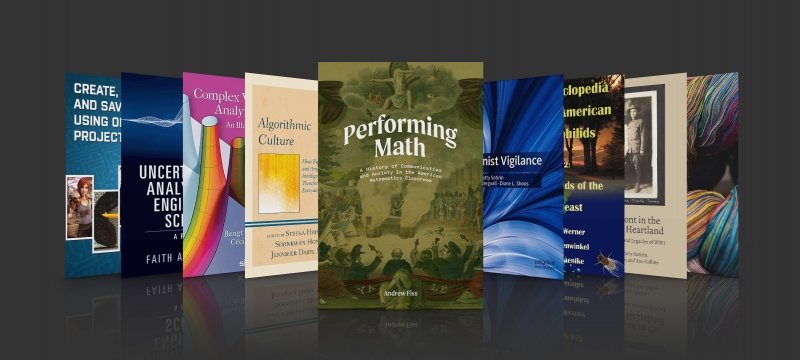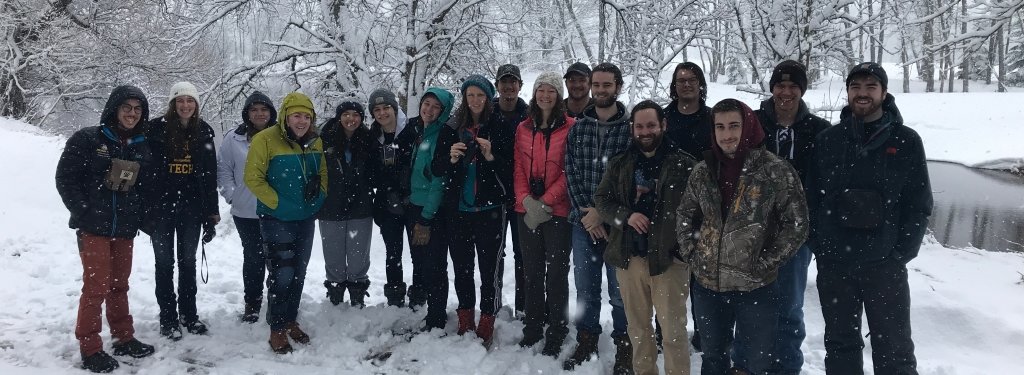The following projects are some of the long-form scholarly works produced last year by Michigan Tech faculty including books, anthologies, field guides, and sculpture.
Trenzando/Braiding
"Trenzando/Braiding is a sculpture that recognizes the intertwined histories of the US and Guatemala, and the role of economics in genocide."
Trenzando/Braiding considers the history of US intervention in Guatemala—and US complicity in Guatemala’s genocide—while reflecting more generally on international cultures of violence. The sculpture is made of 20 units formed into a grid. Textile braids rest on wooden supports, with US dollars and Guatemalan quetzales woven throughout. The braids may remind viewers of human hair; the currencies woven within them point toward the economics of genocide. Twenty is also one Mayan number for “a body.” Choosing twenty units for the piece makes the work a memorial to bodies lost. As Gordillo puts it, “I wanted to acknowledge the connection between our cultures, US economic policies, and their violent results in Guatemala—intertwined, like a braid.”
Home Front in the American Heartland
"This multidisciplinary collection offers rich portraits of the understudied but complex experiences of WWI and its aftermath in the northern American Heartland including the Copper Country."
Home Front in the American Heartland: Local Experiences and Legacies of WWI, is co-authored by Sotirin, Steven Walton, associate professor of history, and Sue Collins, associate professor of communication, culture, and media. The collection offers a multifaceted exploration of World War I and its aftermath in the northern American Heartland, a region often overlooked in wartime histories, explored during a 2018 centennial conference. The collection features rich primary documentation and extensive use of vintage photographs and archival poster art. The first section, “Heartland Histories,” explores experiences of conscription and home-front mobilization in small communities, highlighting tensions associated with patriotism, class, ethnicities, and locale. Section Two, “Homefront Propaganda,” examines the cultural networks disseminating national war messages, notably the critical work of local theaters, Four Minute Men, the Allied War Exhibitions, and local commemorative displays of military relics. Section Three, “Gender in/and War,” highlights under-studied gendered figures including the patriotic mother, the androgynous figures in wartime propaganda, and male serial killers in the traumatized postwar societies in the US and Germany. Unique elements include previously unpublished prisoner of war (POW) cartoon art from the US Air Force archives, a map of Wisconsin WWI memorial sites, and images of WWI visual culture.
Drosophilids of the Southeast
"Our book is about the fruit fly species (drosophilids) that inhabit the southeastern states of the United States."
The book, Drosophilids of the Southeast, is a field guide to the fruit flies (drosophilids) of the southeastern US. It is the second volume of the overarching work, called The Encyclopedia of North American Drosophilids, with Drosophilids of the Midwest and Northeast being volume one. This book is intended to be used by scientists, teachers, and students. It also has a bedtime story at the end, featuring cute fruit fly drawings made by Werner's daughter as an outreach component to the next generation of readers. The books are freely available through the Michigan Tech Digital Commons and include a section on “how to get rid of fruit flies in the kitchen, described in fruit fly traps in volume one,” Werner says. The book is co-authored by Werner, master’s student Tessa Steenwinkel, who contributed to the encyclopedia as an undergraduate researcher, and John Jaenike from the University of Rochester.
Performing Math
"Performing Math is a new history of American college students, speaking in front of blackboards, singing math songs, taking written tests, and putting on math plays."
Performing Math: A History of Communication and Anxiety in the American Mathematics Classroom tells the history of expectations for math communication—and the conversations about math hatred and math anxiety that occurred in response. Focusing on colleges from around the time of the American Civil War, this book goes back and forth between analyzing actual student performances about math (songs and plays), and classroom expectations for students' math communication: how students were expected to read from textbooks, speak in front of the blackboard, and take written tests. Math communication and math anxiety went hand in hand as new rules for oral communication at the blackboard inspired student revolt and frameworks for testing student performance inspired performance anxiety. With unusual primary sources from over a dozen educational archives, Performing Math argues for a new, performance-oriented history of American math education. It also analyzes a lot of humor about American mathematics in a fun way.
Uncertainty Analysis for Engineers and Scientists
"We are all decision makers. Decision making with numbers means taking the time to understand what the numbers mean."
Times have changed: Computers and calculators have greatly reduced the difficulty of scientific and engineering calculations, but using them has also reduced the “number sense” of engineers and scientists. Error analysis can provide a solution to this problem if practitioners only take the time to perform and explore a well-designed uncertainty analysis. This book provides a systematic, worksheet-based process to determine error limits on measured quantities. Morrison gives instructions on how to carry out error analysis using Excel and MATLAB software, making previously tedious calculations easy.

Complex Variables and Analytical Functions
"For most students, formulas alone do not provide a sufficient introduction to complex analysis. This unique book uses colorful figures to illustrate this widely taught topic."
Complex variables and analytic functions are at the crossroads of many disciplines and are used in courses on pure and applied mathematics, physics, and engineering, among many others. This book makes extensive use of illustrations to provide an insight into the world of complex variables and analytic functions. Complex Variables and Analytical Functions: An Illustrated Introduction does this by: using graphics to visually build on familiar cases and illustrate how these same functions extend beyond the real axis; covering several important topics that are omitted in nearly all recent texts, including techniques for analytic continuation and discussions of elliptic functions and of Wiener-Hopf methods; presenting current advances in research, highlighting the subject's active and fascinating frontier. The book is co-authored by Piret and Bengt Fornberg from the University of Colorado Boulder.
Feminist Vigilance
"Feminist Vigilance invites readers to recognize vigilance as a practice of care and carefulness not only for ourselves but for each other."
This book is a collection coedited by Sotirin, Diane Shoos, professor of visual studies and French, and Victoria Bergvall, associate professor of linguistics. The assembled chapters develop feminist vigilance by elaborating concrete examples that emphasize action, ethics, and hope. Chapter authors expand on current feminist discussions: Black women’s self-care and anticipatory vigilance; media portrayals of race, gender, and violence; religion and social justice; technofeminist activism; postcolonial feminist critique; research ethics; and collective civic action. The contributions engage with larger discussions of social precarity, public anxiety, postfeminist appeals, and future feminist trajectories. Feminist Vigilance aims to address the need for productive academic responses to contemporary challenges to gendered identities, feminism, and intersectional relations. This collection invites readers to engage in feminist vigilance as a fresh perspective, commitment, and strategy.

Historic Resource Survey: Pullman National Historical Landmark
"The survey uses the combined skills of four faculty members in the Industrial Heritage and Archaeology program to assist the National Park Service in future interpretation and development of the Pullman National Monument outside Chicago."
Four faculty from the Department of Social Sciences worked for over two years on a Historic Resource Survey (HRS) of the Pullman National Monument in Chicago for the National Park Service. The historic site is a company town, built in 1880 by George M. Pullman for the manufacture of opulent passenger railway cars that became synonymous with his name, and the site stands as the best-preserved example of a planned industrial community in America. Its 140-year existence demonstrates the rise and fall and rebirth of industrial communities in America. The HRS investigated the background of the town in terms of railway car manufacturing, examining Pullman as a planned industrial paternalist community in its heyday and its evolving sociotechnical systems over the period of existence. The industrial facilities are mostly gone, but the importance is the town itself and the survey will help guide the Pullman National Monument's development and interpretation for the next decades.

Algorithmic Culture
"Ultimately, Algorithmic Culture calls attention to the present-day cultural landscape as a whole as it has been reconfigured and represented by algorithms."
Algorithmic Culture: How Big Data and Artificial Intelligence are Transforming Everyday Life explores the complex ways in which algorithms and big data, or algorithmic culture, are simultaneously reshaping everyday culture while perpetuating inequality and intersectional discrimination. The collection is coedited by Stefka Hristova, associate professor of digital media, Soonkwan Hong, associate professor of marketing, and Jennifer Daryl Slack, distinguished professor of communication and cultural studies. The contributors situate issues of humanity, identity, and culture in relation to free will, surveillance, capitalism, neoliberalism, consumerism, solipsism, and creativity, offering a critique of the myriad constraints enacted by algorithms. This book argues that consumers are undergoing an ontological overhaul due to the enhanced manipulability and increasingly mandatory nature of algorithms in the market, while also positing that algorithms may help navigate through chaos that is intrinsically present in the market democracy.
Create, Share, and Save Money Using Open-Source Projects
"The book is a detailed guide to live a more sustainable and economical life using open-source technology."
Create, Share, and Save Money Using Open-Source Projects lays out the many ways in which you can employ these resources on a small scale to live a more economical and sustainable lifestyle. Designed for beginning hobbyists and makers, this engaging guide is filled with ways to save money by making use of free and open-source technologies on a wide and impressive range of products. The book reveals the potential of at-home manufacturing and recycling projects―and even how to score free big-ticket items, including housing and electricity. All the projects have big money saving in mind, but also big fun with DIY projects from digital photographs and videos, to scientific equipment, to patterns for clothing, to security systems.
Michigan Technological University is an R1 public research university founded in 1885 in Houghton, and is home to nearly 7,500 students from more than 60 countries around the world. Consistently ranked among the best universities in the country for return on investment, Michigan's flagship technological university offers more than 120 undergraduate and graduate degree programs in science and technology, engineering, computing, forestry, business, health professions, humanities, mathematics, social sciences, and the arts. The rural campus is situated just miles from Lake Superior in Michigan's Upper Peninsula, offering year-round opportunities for outdoor adventure.












